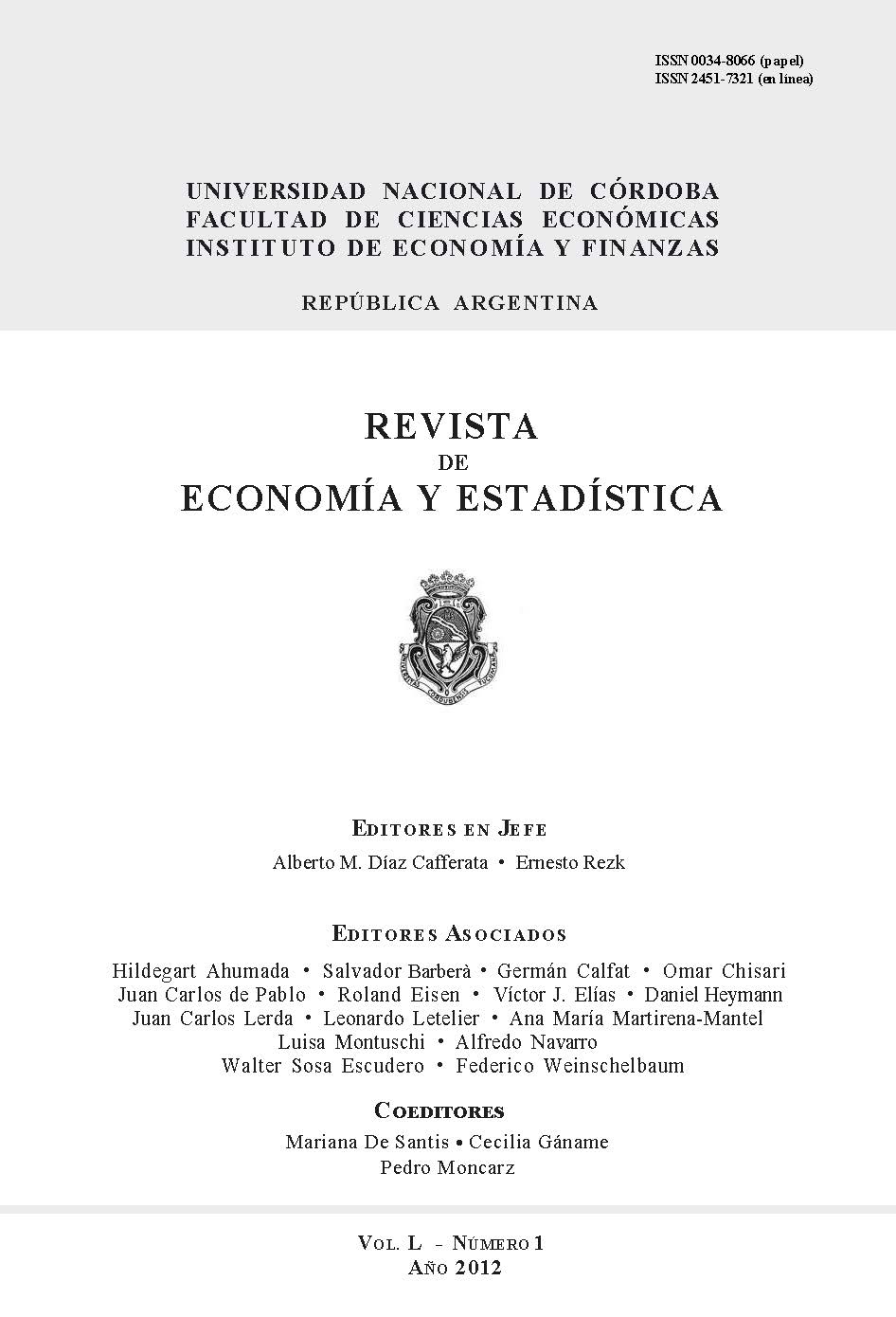Trade variables and Current Account “reversals”: Does the choice of definition matter? An application to Latin American countries
DOI:
https://doi.org/10.55444/2451.7321.2012.v50.n1.10253Keywords:
current account, debt, reversal , probit, comparisonAbstract
This paper demonstrates that the choice between alternative definitions of current account reversal suggested in the literature does matter for the identification of the frequency and dating of reversals. Using variables suggested by the solvency hypothesis three models of a random effect probity are estimated, and the results are compared to highlight the role of the statistical identification of “reversal” used in the exercise. Growth, exports, and changes in terms of trade, are significant, and have the expected signs. The results highlight both the critical role of trade variables in the genesis of reversals and that the choice of definition matters for the sign and significance of determinants.
Downloads
References
Algieri, B. and Bracke, T. (2007) “Patterns Of Current Account Adjustment. Insights From Past Experience". European Central Bank. Working Paper Series N 762.
Bagnai, A. and Manzocchi, S. (1999) "Current-Account Reversals in Developing Countries: The Role of Fundamentals.” Open Economies Review, Vol. 10, N 2 (May); 143-163.
Barone, S. and Díaz Cafferata, A. M. (2007) “Comercio internacional y capacidad de endeudamiento externo”. 40 Jornadas Internacionales de Finanzas Públicas, Facultad de Ciencias Económicas, UNC (Septiembre).
Barone, S. and Díaz Cafferata, A. M. (2006) “Rigidities in Openness, Export Performance and Indicators of External Solvency in Argentina”. In Gabriele Tondl (Eds.) Trade and Integration The EU and Latin America. Viena University of Economics and Business Administration.
Calvo, G.; Izquierdo, A. and Mejía, L. (2004) "On the Empirics of Sudden Stops: The Relevance of Balance-Sheet Effects". NBER Working Papers 10520, National Bureau of Economic Research.
Díaz Cafferata, A.M. Berbotto, L. and Kohn, D. (2007) “Fluctuations of the Current Account and the Causes of the Argentine Long-run Growth Slowdawn.” En Eisen et. al. (Eds.) Trade, Integration and Institutional Reforms in Latin America and the European Union, Peter Lang, Frankfurt.
Díaz Cafferata, A. M. Kohn, D. and Resk, E. (2005) “Motivo crecimiento y la evolución de la cuenta corriente argentina de largo plazo: 1884-2003”. XL Reunión de la Asociación Argentina de Economía Política. (16-18 noviembre). Universidad Nacional de La Plata.
Edwards, S. (2007) "Crises and Growth: a Latin American perspective". NBER Working Papers 13019, National Bureau of Economic Research.
Edwards, S. (2005) “Is the U.S. Current Account Deficit Sustainable? If Not, How Costly Is Adjustment Likely to Be?.” Brookings Papers on Economic-Activity; 211-271.
Edwards, S. (2004a) ”Financial Openness, Sudden Stops, and Current Account Reversals”. American Economic Review, Vol. 94, N 2 (May); 59-64.
Edwards, S. (2004b) "Thirty Years of Current Account Imbalances, Current Account Reversals, and Sudden Stops”.IMF Staff Papers, Vol. 51, Special Issue (January); 1-49.
Freund, C. (2005) “Current Account Adjustment in Industrialized Countries”. Journal of International Money and Finance, Vol. 24, N 8 (December); 1278-1298.
Freund, C. and Warnock, F. (2005) "Current Account Deficits in Industrial Countries: The Bigger They are, the Harder They Fall?". NBER Working Papers 11823, National Bureau of Economic Research.
Glick, R. and Rogoff, K. (1995): “Global versus Country-Specific Productivity Shocks and the Current Account”. Journal of Monetary Economics, Vol. 35 (April); 159-192.
Izquierdo, A. (2002) "Sudden Stops, the Real Exchange Rate and Fiscal Sustainability in Argentina”. The World Economy, Vol. 25, N 7 (July); 903-923.
Komárek, L.; Komarkova, Z. and Melecky, M. (2005) "Current Account Reversals and Growth: The Direct Effect Central and Eastern Europe 1923-2000". The Warwick Economics Research Paper Series (TWERPS) 736, University of Warwick, Department of Economics.
Lane, P. and Milesi-Ferretti G. M. (2006) "The External Wealth of Nations Mark II: Revised and Extended Estimates of Foreign Assets and Liabilities, 1970-2004.” IMF Working Papers 06/69, International Monetary Fund.
Lucas, R. (1990) "Why Doesn´t Capital Flow from Rich to Poor Countries". American Economic Review, American Economic Association, vol. 80(2), pages 92-96, May.
Milesi-Ferretti G. M. and Razin A. (1998) “Current Account Reversals and Currency Crises: Empirical Regularities”. NBER Working Paper 6620, National Bureau of Economic Research.
Obstfeld, M. and Kenneth R. (1996) Foundations of International Economics. MIT Press, Cambridge, Mass.
Reinhart, C. (2005) "Some Perspective on Capital Flows to Emerging Market Economies”. NBER Reporter, Summer.
Wooldridge, J. (2002) Econometric Analisis of Cross Section Panel Data. Cambridge, MA. MIT Press.
Downloads
Published
How to Cite
Issue
Section
License
Copyright (c) 2012 Sergio Barone, Ricardo Descalzi, Alberto M. Díaz Cafferata

This work is licensed under a Creative Commons Attribution-NonCommercial-NoDerivatives 4.0 International License.
Authors who have publications with this journal agree to the following terms:
Authors retain their copyright and grant the journal the right of first publication of their work, which is simultaneously subject to the Creative Commons Attribution-NonCommercial-NoDerivatives 4.0 International License that allows third parties to share the work provided that its author and first publication in this journal are indicated.
Authors may adopt other non-exclusive licensing arrangements for distribution of the published version of the work (e.g. depositing it in an institutional telematic archive or publishing it in a monographic volume) as long as the initial publication in this journal is indicated.
Authors are allowed and encouraged to disseminate their work via the Internet (e.g. in institutional telematic archives or on their website) before and during the submission process, which can lead to interesting exchanges and increase citations of the published work. (See The Open Access Effect)









